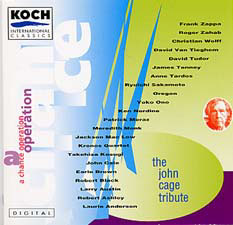

(various artists, 2CD, KOCH International Classics 3-7238-2 Y6x2, October 26, 1993)
UMRK, 1993

Frank Zappa contributed a track for a double CD tribute to the music of John Cage. Appropriately enough his song to cover would be the infamous 4'33".
Does anyone have a recording of FZ's performance of 4'33"?
Yes, I do! He pulled the "dead air" trick a few times in front of baffled audiences in the 60's, so actually releasing a 4'33" cover was only natural for Frank. You've gotta buy two CD's to get it, but "A Chance Operation—John Cage Tribute" is a very interesting project in it's own right. I enjoy the stuff by Laurie Anderson, Meredith Monk, and Ryuichi Sakamoto the best, but it also features word-jazz-guy Ken Nordine, Yoko Ono, Oregon, Kronos Quartet, and John Cale.
The Zappa track itself is divided up into five tracks for some reason. The whole album is this way, it's 85 tracks long.
As for actual sound during the performance, well, I won't spoil it, I'll just say you've got to turn it way up, there is a little bit of him in there somewhere. Maybe I'm imagining it, but I get the distinct feeling of that ever-present glowering sneer from this track. Kind of like you, the listener, get what you deserve for actually buying and listening to this track. I could be wrong.. it could be a totally serious tribute, but I think there's a bit of a pan to the listener as well. You decide.
So then Patrick Neve
The Zappa track itself is divided up into five tracks for some reason. The whole album is this way, it's 85 tracks long.
The reason being, you pop the discs into ye olde lecteur de disques compactes, hit shuffle, and enjoy a somewhat authentically Cagean event.
I agree with your take on Zappa's "interpretation" of 4'33". It does have his eyebrows. I also like his deadpan and minimalist biographical note. I won't repeat it here, because to really appreciate it you need to see it in the context of the booklet. But you, Patrick, and a few others, will know exactly what I'm talking about.
4'33" had its debut in 1952 and at that time it created an absolute firestorm of controversy. Was Cage really serious? Or was he hoodwinking his audience? It caused quite an outrage. And while Cage was reluctant to cite a favorite piece of his, he would often give in and say it was 4'33".
In putting together A Chance Operation I gave quite a lot of leeway to the artists in allowing them to pay tribute in a way they saw fit, but I did make some broad recommendations here and there. So on this recording you'll see a mix of original works, Cage works and variations on Cage works. Frank was definitely on my initial list of artists to contact for this project. I sent him a fax and received a reply from his assistant who explained that while Frank was definitely a fan of Cage's work and he wished me the best on the project, he didn't have enough time at that moment to work on the project. In retrospect that phrase has spooky connotations.
As the project continued to develop, my research into Cage made me feel that 4'33" had to be represented on the album. But who to do it? I gave this matter considerable thought and came up with two people I felt the best candidates for the performance—Frank and Brian Eno. I felt both would approach the task very seriously. Further consideration tipped the scales towards Frank. Why? The original performance caused major controversy. I felt Eno so well suited for the role that everyone would simply accept it. But Zappa had a reputation for outrageousness. While I felt he would approach the task seriously, I felt his performance of it would raise questions and cause controversy perhaps recreating some of the controversy of the original performance.
But then, Frank had already turned me down! Well, since that was the case, I apparently had nothing to lose, so I thought I'd try again. So, I sent him another fax. I thanked him for his good wishes on the project and said I certainly understood the problem of time constraints. Then I said something to the effect of, "...but if you're really interested in the project and would like to contribute, I have an idea that wouldn't take up much of your time—in fact, not much more than 4'33"!"
A few days later I received a call from Gail Zappa. According to Gail, Frank loved the fax and after setting it down he immediately went into his studio and recorded the piece then and there. So where would I like it sent? I was floored! And delighted of course. Frank later plugged the project in an extensive interview he did.
When the CD was initially released I recall that there was one review that zeroed right in on Frank's performance and, tongue in cheek, queeried how the listener could be sure it was really him and further suggested we could have attributed the track to Pavarotti, the Beatles, or even God! The controversy had begun. But, sadly, Frank left us just a month after the release of the CD. So it was a controversy no one else wanted to touch. His passing was certainly depressing for me and I was saddened to know that Frank never got to hear the project in its final form.
Here's a link to The Artist Shop where people can find A Chance Operation along with a couple of other things I was involved in.
I think it has something to do with 4'33 min = 273 seconds. -273 centigrades = zero degrees Kelvin, where everything would be completely silent. Or am I just dreaming this up?
Sound waves cannot propagate in a vacuum.. I'm not sure if zero Kelvin creates a vacuum or not, but that's the only thing I can think of. What's the atmospheric pressure of zero Kelvin?
I really like the connection between the intruments' silence in 4'33" and the "silence" due to lack of motion in particles at -273 degrees Centigrade. It's simple, neat, and elegant.
At zero kelvin there is "no" movement of atoms relative to each other, but the atoms are still there. A vacuum is defined as an area of space with no atoms at all. So if you cool down an area with an atmosphere to zero Kelvin, by (PV=nRT), you reduce the air pressure to zero, but you do not create a vacuum. This is a pretty close model of outer space, but I think space is actually about three degrees Kelvin due to background radiation left over from the Big Bang (Pamela Des Barres and Led Zeppelin) and trace amounts of hydrogen all over the place.
In his biography (in which he was fully involved), "The Roaring Silence: John Cage: a Life" (1992) by Dave Revill, Cage explains how he came up with 4'33". Given the nature of pieces of music from his period of "Indeterminacy" (as it has been labelled)—i.e. they are not determined—it is quite unlikely that Cage would have been thinking in terms of science when he was composing. But, as he himself might have said, the numerical coincidence is a part of the piece—the fact that it was unintended would have suited him well. Maybe it is a sign that when one lets chance operations determine a piece, the pattern of the universe makes itself seen...
Additional informant: Chris Wilson